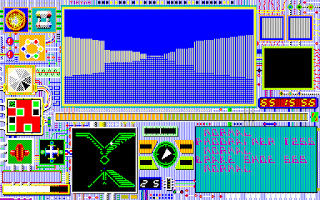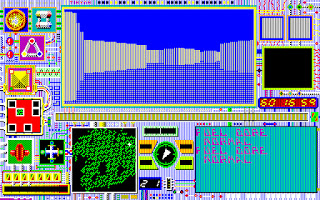
Name:SeeNa
Number:96
Year:1986
Publisher:SystemSoft
Developer:SystemSoft
Genre:Racing
Difficulty:5/5
Time:8 hours
The history of Japanese computer games is a perplexing thing. Sometimes they pointlessly tread the same ground the west has done for years and years, and other times they innovate. SeeNa is one of those innovations. A first-person racing game is nothing unusual, this is far from the first title to do it. However, once you see some screenshots, you'll realize why this is an impressive title.
 |
Behold, a racing game
|
This is because SeeNa hits upon almost exactly the same notes as Hovertank, Catacomb and all the rest of the untextured FPS titles would do. Now, admittedly, the game is somewhere between a maze game and a racing game, but to see it done much earlier is shocking. Midi Maze, was one year after this, I admit, but SeeNa feels so much more modern. Levels, in the sense I expect them, secrets, secret levels. This doesn't really feel like a commercial game because those usually aren't this impressive technologically.
When the game starts off you have two modes, one called Mode A, and one called Mode B. You can think of this as Adventure Mode and Race Mode. Adventure is effectively the actual game, and Race Mode is what you expect from a racing game. A series of tracks you try to get the fastest time around. I'll start with that mode first.
 |
Note the sections where the track goes back in on itself, this is achieved via teleporters
|
There are several unusual things about the game even in this mode. The most obvious is the damage meter and the gasoline tanks. Take enough damage, or run out of gas, game over. There's a pit stop so you can repair and refuel. I say gas is obvious, but I didn't figure out that it was a thing until considerable time spent in the game. Mode B was something I didn't play right away. Then you have break and slip zones. Break zones slow you down, slip removes your traction, I.E., turning, speeding up, speeding down, the time between you pressing it and it happening is very slow. But not too dissimilar to slow down zones and ice in other games.
 |
Just your average racetrack
|
Some of the tracks in Race Mode are weird, and there's no rhyme or reason to where they're placed. One moment you have a normal track, the next your map isn't showing everything there, and then you're in something that wouldn't be out of place in Catacomb Armageddon. Then it finishes with something normal. If you played it after the finishing the other mode, you'd probably be disappointed, because its just a simple time trial, and one that you can't lose; Unless you're a complete beginner at the game.
 |
Behold, a racing game...?
|
Mode A is where things change from being a racing game with unusual tech, to something interesting. You start off in a room, you turn around, there's nothing here. The only thing unusual is a flashing wall, so you drive through it. Its a map tool and this isn't just some race track. No, this is an actual level, with enemies and things you pick up. Its very unusual to play a racing game like this, and its other features are also unusual. You have limited gas and you need to find pick-ups that restore it. Later on there's a powerup that allows you to recharge it in certain zones, but this is of limited utility.
 |
On top of an enemy, taking damage
|
But what's striking about this is how you deal with powerups, switches, enemies and the level exit. A lot of this stuff is in the form of flashing walls. You can destroy everything (except level exits) if you pass over it at a certain speed, which is good for enemies and I think switches, but not so good for everything else. Naturally, the game is designed around making this concept as annoying as possible for you, including putting enemies you wish to kill right next to solid walls, which hurt you.
For the early part of the game, level design is interesting. Its unsurprisingly not too dissimilar to the typical FPS, released 5-8 years later. Altered, of course, to accommodate the speed aspect of the game, and no saves. The game doesn't allow you to save, at all, and it isn't all that much worse for the wear for it, at least starting out. The game encourages you to play it in the best way possible, finding items in the correct order, using as much gas as you need, and ignoring places you don't need to travel through.
 |
Every bit of the map is like that, even the parts I haven't uncovered
|
The level where the game really starts screwing with the player is Saka. Or at least that's one of its names. The level is a series of corridors that resemble train tracks. The sort of turns they put in so they don't tip over. Its a very large, very complex level. There is some fuel, but it is limited in nature. This area has a city, or I guess super computer, you destroy in order to win. It continues the cruelty by hiding the level exit, and possibly causing it to be lost forever if you hit the wrong switch. Destroying the super computer starts a timer, of which you have sixty...something to get out of the level. I eventually manage to win this level...but the game continues. I wasn't expecting that.
 |
One of the secret levels I couldn't beat
|
But, no, it keeps going. Not just for one level, but for two more, at least. There's even a secret level here. This had me perplexed on many levels, because Saka felt like a proper end to the game, and two, because of the game not having any saves, we're starting to get really long. This isn't annoying for me, because I have save states, but for someone playing on actual hardware or legit? Nuts. You have to get everything right. There are even more super computers to destroy too.
 |
This would be annoying in any game
|
Unfortunately, I'm forced to put a loss column here for this game, despite almost winning it. Almost. I think. I don't really need to cite anything other than this screenshot, but I'm going to explain. In all of this, I need to find a level exit. I may also need to find a switch to open that door. Which adds the total number of things I need to find, with limited fuel, to 2. In all of this. I remember thinking this would be a fun game to see people speedrun, and while that's still something I'd like to see, I'm not sure if that person is even human anymore.
 |
Winning levels show you these pictures, sometimes complete, sometimes mixed in with ones from other levels
|
The secret levels, at least those I could find, were pretty good as secret levels. I only finished one of them thanks to it being a 1-in-3 chance of automatically winning the level, but I gave the others a valiant effort. Thanks to some incompetence on my part, I'm not sure if that's because I screwed it up or if the game was intentionally designed so that these levels would be unbeatable if I didn't find the right powerups beforehand. I still felt like I had succeeded in doing something when reaching them, which is the important bit.
 |
Mahjong tiles feature heavily in this level, for some reason
|
Let's talk about the real problem with the game, the audio-visual package. You've seen the pictures. Its very cool seeing this in 1986. However, it is very hard on the eyes in motion. And because of the limited color palette, sometimes the movement looks awkward. Further, the
music sounds pretty sweet the first time you play the game, but this game is at least 8 hours long and there's not even 20 minutes of it. There's no way to turn off the sound without changing settings.
Weapons:
None.
Enemies:
Incredibly basic and practically non-existent. 0/10
Non-Enemies:
None.
Levels:
There's a wide gap in the quality of the best levels and the worst levels. Not necessarily because the best levels are the greatest thing ever, but because the worst levels are about as bad as you can possibly get. There is just no point in time where the last level in this game is acceptable. 5/10
Player Agency:
You move smoothly when the game wants you to move smoothly. You don't when they don't. There's a really awkward period at low speeds where you have a really slow turn arc, but not at minimum speed, which is annoying. Otherwise no complaints. 5/10
Interactivity:
Its basically Quake rules, if you were a car. 0/10
Atmosphere:
There aren't many in-door racing games, be they sci-fi or otherwise. It feels like a journey through a futuristic world, even if the story could be about something else entirely. 2/10
Graphics:
Simple, but very interesting for the time. Unfortunately, thanks to the way the game is set-up, it quickly becomes very tedious to look at. The HUD is incredibly busy too, took me a while to figure out what area had my fuel. 2/10
Story:
None in-game, though there could be something in the manual.
Sound/Music:
The sounds are very simple, and the music, while interesting at first, quickly became annoying. 1/10
That's 15. Its an interesting game, but it has several severe flaws. Its an area ripe for new material. Not like some actual racing games some have made in the Doom engine, but something like this, solo, alone in an alien world.
I don't really know how many more titles the lead programmer of this game, Tinyan, has, nor how many SystemSoft have. SystemSoft seems to be the Japanese Microprose, developing original simulations and publishing similar games from other regions.











No comments:
Post a Comment